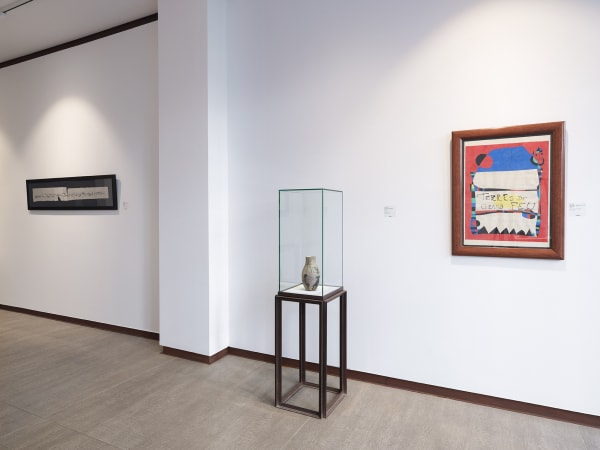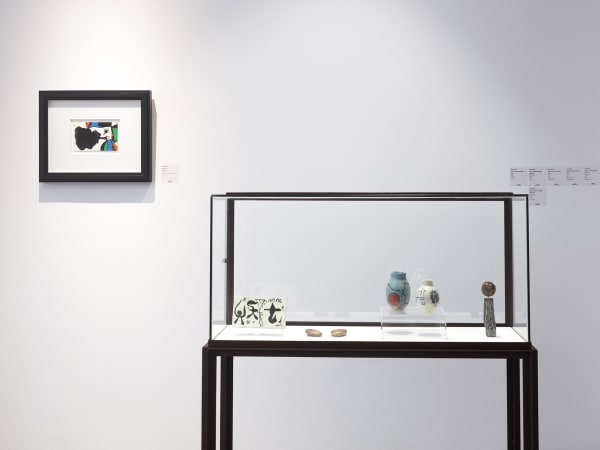Past exhibition
Overview
The Mayoral Gallery is pleased to present the exhibition "Ethics and Aesthetics: Miró/Artigas", curated by the expert in Miró’s work, Robert Lubar Messeri, and comprising a selection of thirty pieces created by the Surrealist artist Joan Miró, the ceramist Josep Llorens Artigas, and the latter’s son, Joan Gardy Artigas.
Particularly important among the works on show are the Miró/Artigas ceramics Vase (1941-46), in which Miró began conceiving his figures in a new spatial format that followed the contours of the vessel, and Personnage terre rouge (Red Clay Figure, 1945), whose form suggests a natural arch or a man-made portal, plus the Joan Miró gouache Femme (Woman, 1973), a drawing in which, as in the ceramic works, he experiments with new artistic forms in order to create a dialogue between form and colour.
This is the first gallery exhibition since 1964 to highlight the symbiotic, fruitful and lengthy collaboration between two great artists, which marked the trajectory of both, and via which they “conquered a place in the history of art through the creation of their emblematic murals and sculptures, which continue to have a civic and artistic symbolism of great force and relevance,” according to the the directors of the gallery.
To mark the exhibition, a catalogue has been published that includes texts by the curator, Robert Lubar Messeri; the artists themselves, Joan Miró and Josep Llorens Artigas; the ceramist Edmund de Waal, and by other experts in the creative procedures of Miró and Artigas such as Georges Raillard, Jacques Dupin, Joan Gardy Artigas and William Jeffet. For the carrying out of this project the collaboration has been essential of the Fundació Josep Llorens Artigas (Gallifa), the Successió Miró (Palma de Mallorca), the Fundació Joan Miró (Barcelona), the Musée Zervos (Vézelay) and the Col·legi Oficial d’Arquitectes de Catalunya (COAC).
In 1938, during his exile in Paris, Joan Miró had expressed his desire to experiment with new artistic techniques “that go beyond easel painting.” A few years later, as witnessed by his own notes in 1942, Miró made the connection between ceramics and the popular traditions of Mallorca, his haven during the Second World War. That same year the artist visited a friend from the early days, the ceramist Josep Llorens Artigas, in Barcelona, an encounter that initiated an artistic collaboration of more than four decades. The joint creations of Miró and Artigas break once and for all with the ceramic tradition of “plaque and vase,” and give rise to a new expressive universe of fantastic, grotesque figures. Both artists worked towards adapting Mironian symbolism to a new medium that offered them a range of new expressive possibilities. On the one hand Miró experimented with volume, adding voids and protuberances to his figures, and developing an aesthetic that is reminiscent of primitive art. On the other, the erosion and petrification specific to this age-old technique, which Artigas masterfully dominated, endows the figures with a rich materic finish that evokes the archaeological remains of a lost civilization.
The collaboration between Miró and Artigas was articulated around experimenting with ceramics as an expressive vehicle, thus denying all possibility of creating a decorative art, and concentrating their efforts on crystallizing their ethical convictions through a technique historically relegated to the category of handicraft. In the words of the curator of the exhibition, Robert Lubar Messeri: “The desire [Miró] expressed in 1938, to bring himself closer to the human masses, an attitude he shared with Artigas, had been realized with the execution of his first mural commission. […] Plumbing the depths of human civilization from popular traditions and medieval architecture and mural painting to contemporary public art, Miró and Artigas traced a temporal arc between the distant past and the immediate present.”
Curated by Robert Lubar.
Installation Views
Publications











